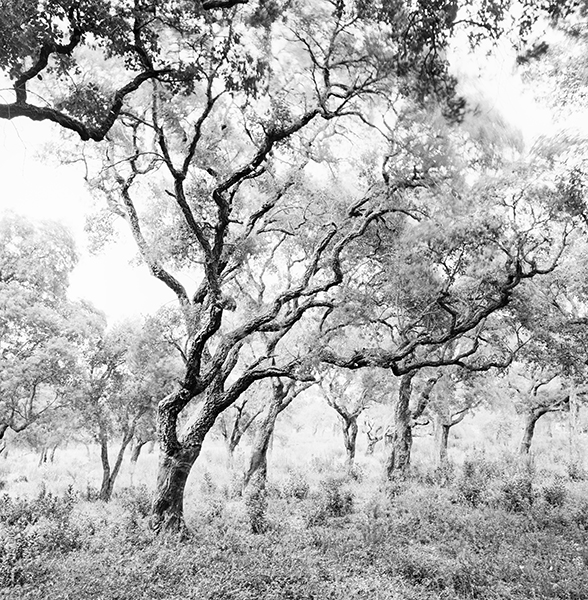PAST EXHIBITIONS
GIANNI BERENGO GARDIN
Polesine
March, 21st – May 14th 2015 only by appointment please email to galleria@issf.it
 SHOW GALLERY
SHOW GALLERY
Paolo Morello
The Tale of The Banyan Tree
February 14th - March 14th 2015
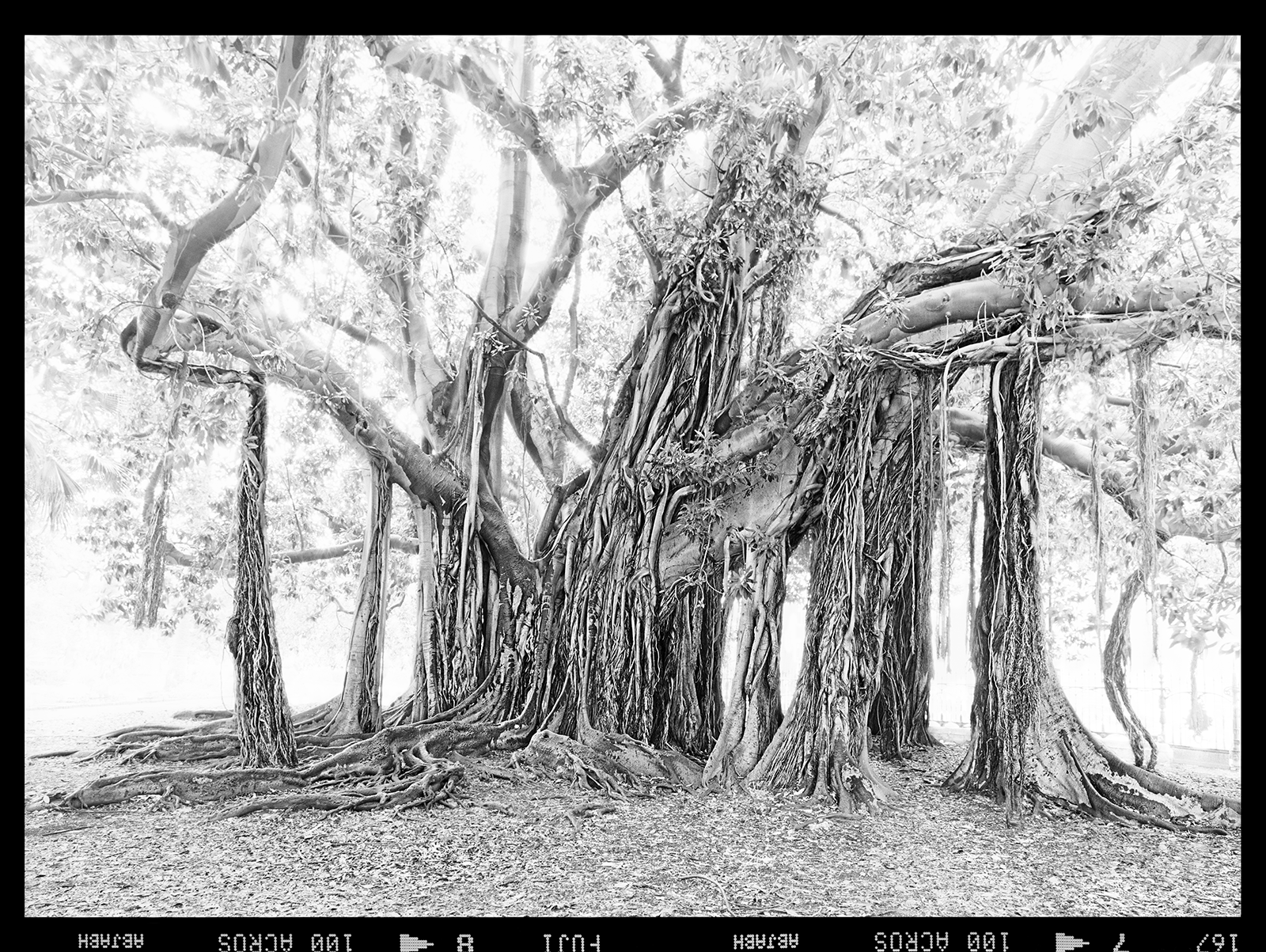 SHOW GALLERY
SHOW GALLERY
In India, a huge tree, with large, heart-shaped leaves, grew near the temple of Mahabodhi. It was an old specimen of Ficus religiosa; in Sanskrit, its name — Ashwattha — means ‘that which changes’. According to legends, under that tree Siddharta Gautama sat a long time in meditation, until he got the Bodhi, that is the awakening. For this reason,…
Read moreIn India, a huge tree, with large, heart-shaped leaves, grew near the temple of Mahabodhi. It was an old specimen of Ficus religiosa; in Sanskrit, its name — Ashwattha — means ‘that which changes’. According to legends, under that tree Siddharta Gautama sat a long time in meditation, until he got the Bodhi, that is the awakening. For this reason, that banyan tree is known as the Sri Maha Bodhi, or the Bodhi Tree. Still today, in that place there is a great banyan tree, which is said to descend from that under which the Buddha was enlightened. It is considered a sacred tree, and therefore the name of Ficus religiosa was given to its species. Believers of many religions go on pilgrimage there. Gentle and mighty, generous in affording a shelter to wayfarers caught short by rainstorms or exhausted by the summer heat, its name recurs often in old sacred Indian books and in Buddhist legends. In the Chandogya Upanisad, Svetaketu learns from his father how such a gigantic tree can come from a tiny seed, and how in that Nothing the essence of every thing is hidden. Another species — the Ficus benghalensis — in Sanskrit is called Nyagrodha, which means ‘that which grows downwards’. What makes these trees so monumental and moving is the framework of aerial roots, which, reaching the ground, become ancillary trunks, and help to support the weight of the foliage. If one agrees that these trees could have a symbolical value, and that their marvellous shapes could be a teaching to men, then one will understand how the issue that the banyan tree raises is that of rooting. It is not just a matter of the strength of the roots, but rather of the will to connect the top with the bottom. The strength of the result depends on this will. Leaves and roots depend on each other: without the latter, the former would die, and vice versa. It is essential that there is an effective connection so that this mutual function can take place. Without a good link, sap could not rise to the top, and, conversely, the energy synthesized by the leaves could not come back to the ground. For these reasons, banyan trees recur in many religions’ symbology, with the name of Tree of the World, with the celestial specularly superimposed to the mundane. It reminds wayfarers that the Top and the Bottom belong to each other.
Gianni Berengo Gardin, Mario Giacomelli, Mario De Biasi, Franco Pinna, Pepi Merisio, Enzo Sellerio, Alfredo Camisa, Carlo Bevilacqua, Piergiorgio Branzi, et al.
The Sacred
December 13th, 2014 - January 30th, 2015
 SHOW GALLERY
SHOW GALLERY
Popular religiousness was a topic of the highest interest in XXth century photography. Often working alongside writers and etno-anthropologists, reporters put a great deal of effort into documenting feasts and rites all around the world, and into representing the multifaceted nature of devotion with its gray edges between true belief and superstition. An extraordinary series…
Read morePopular religiousness was a topic of the highest interest in XXth century photography. Often working alongside writers and etno-anthropologists, reporters put a great deal of effort into documenting feasts and rites all around the world, and into representing the multifaceted nature of devotion with its gray edges between true belief and superstition. An extraordinary series of vintage prints taken by Italian photographers from the second World War period onward are on display until January 30th, 2015 at the Paolo Morello Studio Gallery in Palermo, Italy. The show starts from ‘Italia magica’ (Magical Italy), a series of reportages by Federico Patellani, published in 1952 in ten instalments on the magazine ‘Tempo’. A free-lance photographer, Patellani undertook a journey to Southern Italy to throw light on the magic rites still extremely popular at that time. In the same year, noted etno-anthropologist Ernesto de Martino organized his first ‘scientific expedition’ to Lucania to research on the survival of pagan rites and, particularly, of funeral laments in contemporary societies. A team of scholars, cameramen and photographers travelled with him, among them Arturo Zavattini, Ando Gilardi and Franco Pinna, whose pictures were to be used later on to illustrate de Martino’s groundbreaking books. A few years later, in 1956, Pepi Merisio took a touching series of pictures devoted to the ill people praying at the Caravaggio sanctuary, near Milan. The same did Mario Giacomelli in Lourdes, in 1957 and again in 1959, depicting human suffering as nobody else before him had done. Both Merisio and Giacomelli felt personally much involved in their subjects’ anguish: they were proud to state they were there not just to witness, but to share with those suffering people their pains. Feeling involved is a matter of personal sensibility. It is a matter of fact, nevertheless, that even those photographers who admittedly looked at religion with skepticism could not approach these situations without an emotional involvement. Caio Mario Garrubba was a member of the Communist party, and as a photographer he used to travel to Russia on official assignments. Yet the picture he took in Moscow in 1964 in an orthodox church is moving: the old lady with her eyes closed, one hand on her heart, is a telling icon of the meaning that religion had in Soviet Union. The exhibition reaches its climax in two extremely rare vintage prints by Gianni Berengo Gardin, both taken in Venice in 1957 at the Corpus Domini procession. The psycological intensity of the people portrayed here is unrivalled. Renowned for his witty anticlerical pictures which regularly appeared on ‘Il Mondo’, Berengo Gardin shows here his sympathy toward any expression of human beings. When representing the Sacrum, photographers’ points of view seem to be overwhelmed with a sense of respect. Would they represent christian, muslim, buddhist or jewish rites, they always seem to be stricken by the candour of the circumstance. To represent the Sacrum hid an unexpected challenge for all of those photographers who were engaged in the struggle for realism: nothing is more real, powerful, and actual than a religious belief, yet nothing is more abstract, ineffable, purely mental. So, how to represent in realistic terms the most ineffable feeling? Popular religiousness is always a mix of love and fear, hope and expectations, dogmas and compromises. Mario De Biasi gave a great synthesis of all that in a gorgeous series taken in Chichicastenango, Guatemala, at the feast of St Thomas, in 1972. Under the light of dozens of candles, the believers offer the viewer their fragility, taking part to the rite as the shepherds in a living nativity.
Read lessPAOLO MORELLO
White Light
November 7th - December 20th, 2014
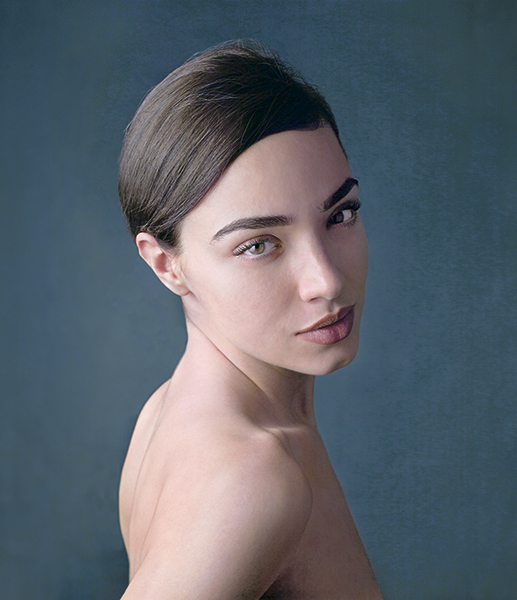 SHOW GALLERY
SHOW GALLERY
A portrait is the desire for sharing. It is an opportunity for a relationship with another person. A marvellous way to establish intimacy. Without these premises, a good portrait can never be realised. Neither knowledge of light nor beauty of proportions could ever give, by itself, a touching result. In every human being we encounter,…
Read moreA portrait is the desire for sharing. It is an opportunity for a relationship with another person. A marvellous way to establish intimacy. Without these premises, a good portrait can never be realised. Neither knowledge of light nor beauty of proportions could ever give, by itself, a touching result. In every human being we encounter, some part is destined to remain forever hidden, intangible and mysterious. And yet, what is more exciting than the curiosity that draws us closer to another human being? Than the possibility of establishing a pact, an understanding, a meeting point between our ideas and his?
Read lessRealism and Abstraction in Italian Photography
May 16th - June 15th 2014
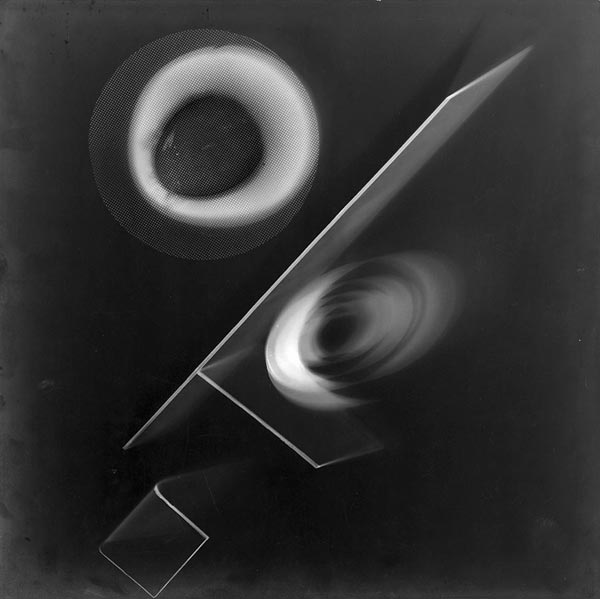 SHOW GALLERY
SHOW GALLERY
Realism and Formalism have been used for years by critics and art historians to mix up political quarrels and artistic choices. The postwar period was indeed a time of conflict and hopes, but over the years this kind of distinction had led too far away from works and photographic debates. After a fifteen-year research, Paolo…
Read moreRealism and Formalism have been used for years by critics and art historians to mix up political quarrels and artistic choices. The postwar period was indeed a time of conflict and hopes, but over the years this kind of distinction had led too far away from works and photographic debates. After a fifteen-year research, Paolo Morello dug out an impressive number of letters, printed materials and pieces of evidence documenting what the photographers’ concerns really were. The stunning selection of sixty vintage prints, now on display at the Paolo Morello Studio Gallery, eventually show how subtle was the edge between Realism and Formalism, how deep were their roots in Italian past and how fruitful their seeds upon the following artists.
Read lessMARIO LASALANDRA
Poets, masks, actors, phantoms
January 18th - March 9th, 2014
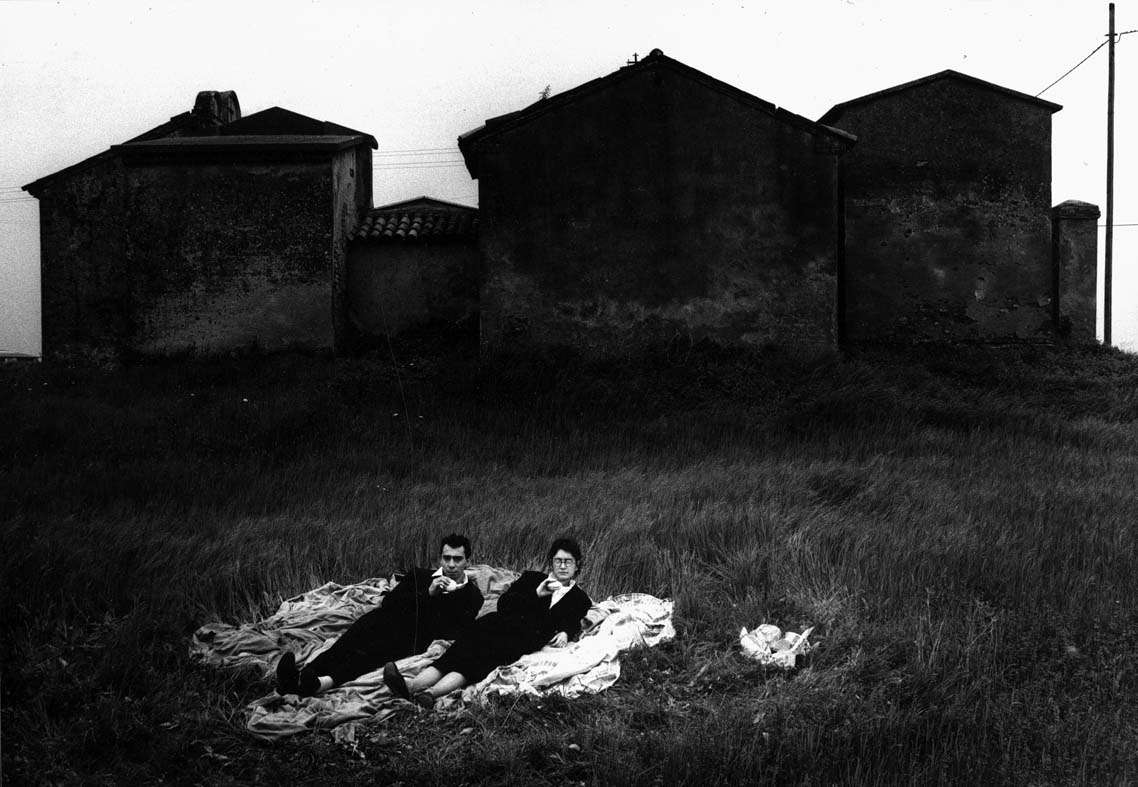 SHOW GALLERY
SHOW GALLERY
Inspired by the films of Bergman, Fellini, Antonioni, and Pasolini, Mario Lasalandra (Este, Italy, *1933) began his career as a photographer in the Fifties. Since then, he has never stopped narrating his fantasies populated by angels, actors, virgins, scarecrows, prophets, and phantoms — an eccentric pageantry, quite unique in 19th century photography. Margherita, 1967, the…
Read moreInspired by the films of Bergman, Fellini, Antonioni, and Pasolini, Mario Lasalandra (Este, Italy, *1933) began his career as a photographer in the Fifties. Since then, he has never stopped narrating his fantasies populated by angels, actors, virgins, scarecrows, prophets, and phantoms — an eccentric pageantry, quite unique in 19th century photography. Margherita, 1967, the portrait of an old lady with a clownish face, recalls both Gelsomina and Cabiria, the main characters of two famous films by Fellini (La strada, 1954, and Cabiria, 1957). Giudizio, 1967, is a sequence of pictures conceived as a visual story, though it has no proper plot. Also Storia di un dramma, 1970, is conceived as a series: it tells the story of a family of actors no longer able to act — the same theme of Fellini’s Otto e mezzo. Amateur players are also the protagonists of Filodrammatici, 1968. They stand side by side in the forefront, at the end of their performance. They are motionless, so different from the restless parades of merrymakers recurring in Fellini’s Le notti di Cabiria and Otto e mezzo, or in Antonioni’s Blow up.
Let’s go back for a moment to the Giudizio series. Two Angels hold violins in their hands, while a white dove rests upon the shoulder of the shortest one. Three white doves also appear in Margherita, as well as in many other later works: Paradiso n. 1, 1991; Muro, 1995; Mario del bosco, 1994; Carnevale triste, 1996; Aldo, 1996; Elena, 2000. White animals recur in several other pictures: a white horse in Paradiso n. 3, 1992, and in Cavallo bianco, 1997; a white goat in Capra bianca, 1996; a white dog in Cane bianco, 2000; two white cats in Giardino di Carmelo, 2000; and finally, several white sheep in Presepio, 2002. White is also the dress of the Virgin, another main character of the Giudizio series; white is the young girl laying in the foreground in Surreale, 1970; and white is the dress of the girl who runs away at the end of Storia di un dramma. Either way, humans or animals, they are symbols of hope.
Extensively exhibited in Europe, Lasalandra’s works are owned by many public collections, among them: the International Center of Photography, New York; the Bibliotèque Nazionale de France, Paris; CSAC, University of Parma; Galleria d’Arte Moderna e Contemporanea, Bergamo.
Read lessMARIO DE BIASI
Vintage masterworks 1948-1978
September 28th - November 3rd, 2013
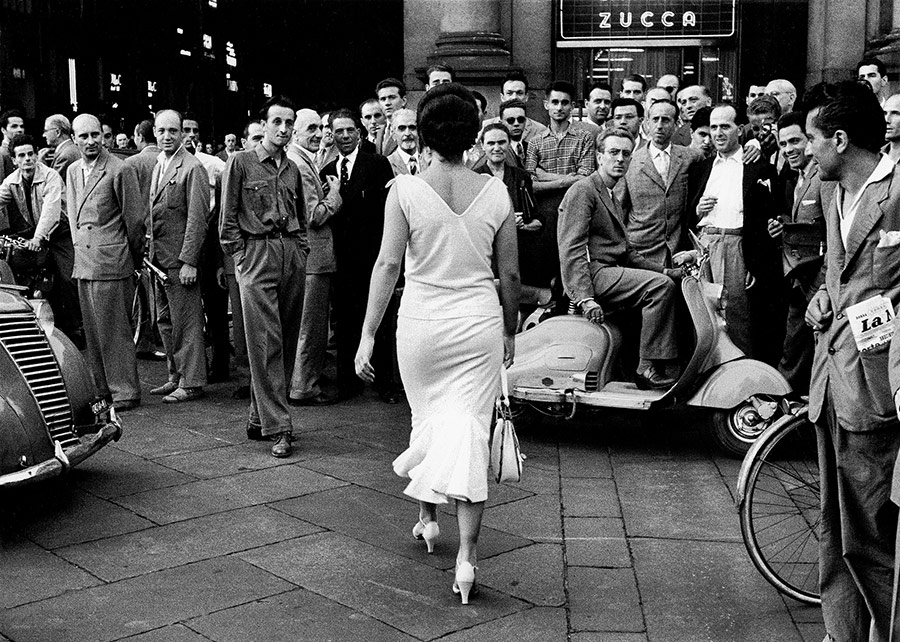 SHOW GALLERY
SHOW GALLERY
Mario De Biasi (Sois, Belluno, 1923 – Milan, 2013) got his first camera in 1945 in Nuremberg, where he had been deported. Over the next eight years, he continuously took photographs and exhibited as an amateur photographer. His early pictures, shot during a journey to Sicily in 1949, evidence his natural talent in catching different…
Read moreMario De Biasi (Sois, Belluno, 1923 – Milan, 2013) got his first camera in 1945 in Nuremberg, where he had been deported. Over the next eight years, he continuously took photographs and exhibited as an amateur photographer. His early pictures, shot during a journey to Sicily in 1949, evidence his natural talent in catching different subjects and keeping them together in the same frame in order to create a story in one single picture. Let’s take a look at his famous Vecchia edicola (Old newsstand), taken in Pavia in 1949: an old lady, dressed in poor clothes, sits in her newsstand – indeed, a hut; all around her, the smiling faces of movie stars fill the covers of illustrated magazines with dreams. What a powerful clash between fiction and reality! De Biasi pursued a different, abstract task in his masterwork Milano. Piazza Duomo, 1951. The paths in the thick snow disclose the patterns of the pavement, forming a multilayered joke. The only existing vintage print of this subject, from Paolo Morello’s collection, was sold at Christie’s in June 2012 for 29,000.00 GBP. In 1953, De Biasi was hired by the Mondadori publishing group. A few months later, he joined the photographic team of the magazine ‘Epoca’ – a cooperation that would last for thirty years. The following year, 1954, he took his most famous picture ever: Gli Italiani si voltano. It shows a charming young lady (the circus trapezist Moira Orfei) walking toward the Galleria Vittorio Emanuele II in Milan, facing a crowd of males gazing at her with naked lust. What an unforgettable gallery of faces! Moreover, this picture soon became an icon of the Italian economic miracle in the post-war period. It epitomizes all of the most popular symbols of that age: the rediscovery of material wealth goes together with a sexual abundance. In 1994, this picture (precisely the print now in Paolo Morello’s collection – the sole existing vintage print) was included in The Italian Metamorphosis exhibition, held at the Solomon Guggenheim Museum, where it was chosen as the poster of the exhibition and adorned the streets of New York for several months. De Biasi went to New York for the first time in 1955, embedded in a haute couture expedition. He stayed a while, met Sugar Ray Robinson, became close friend with his sister, and went with her to the Savoy Ballroom — it would be demolished three years later. He took forceful pictures, which writer Camilla Cederna commented in these terms: «One can breathe in his photographs the wild scent of the sea that at a certain time one can smell in New York, the fragrance of the fair doughnuts in Broadway at night… It hadn’t yet been said everything about New York». De Biasi earned international fame in 1956 in Budapest, where riots had broken out. All of the major magazines sent their photoreporters: John Sadovy was there for ‘Life’, Erich Lessing for Magnum agency, Jean-Pierre Pedrazzini for ‘Paris Match’, and so on. De Biasi’s pictures were initially published in ‘Epoca’, and were so well appreciated that they were bought and published by nineteen magazines all over the world. For the first time, thanks to De Biasi, Italy earned its his place in the Pantheon of international photoreportage. In 1964 De Biasi went back to New York. The view showing the skyscrapers and a walking man reflected in a puddle is definitely one of his greatest masterworks. That same year he went to Siberia, shooting unforgettable pictures at 65° degrees below zero. From there, he flew to central Africa, where the tempature was 56° degrees above zero, therefore we find pictures shots over a range of 120° degrees on the same roll of film! As journalist Enzo Biagi, for many years the head of ‘Epoca’, wrote to him once: «Cheer up, De Biasi! For you nothing is impossible». De Biasi kept on travelling and taking photographs all over the world for many years thereafter — from Alaska to South America, from Polynesia to Nepal. During his glorious career, Mario De Biasi was awarded with dozens of prizes, among them the Erich Solomon Preis in Colone in 1964, the Saint Vincent Price for journalism in 1982, the Life Achievement Award at the Arles Festival in 1994, and many more. He published more than one hundred books. He died in Milano a few days before his ninetieth birthday.
Read lessANTONIO BIASIUCCI
Ex-voto
March 2nd - April 28th, 2013
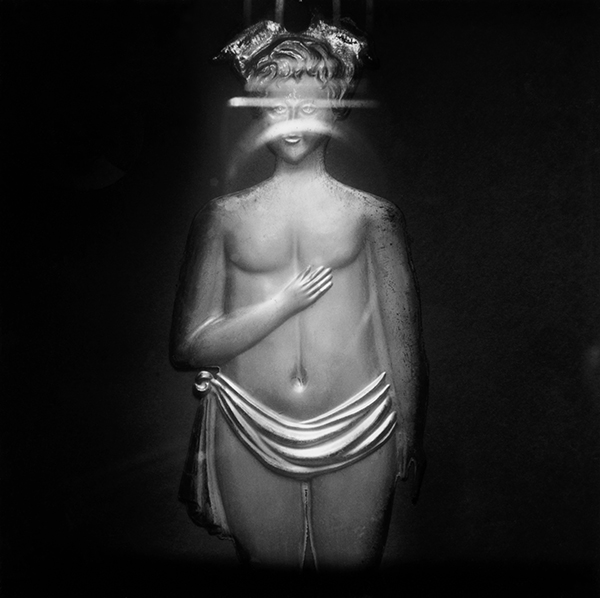 SHOW GALLERY
SHOW GALLERY
Widely acknowledged as the most gifted genius in contemporary Italian photography, Antonio Biasiucci was born in Dragoni (Caserta) in 1961, the son of a commercial photographer. He published his first book at twenty-three, in 1984, Dove non è mai sera, set in his native village, and five years later his second volume, Vapori, 1989, devoted…
Read moreWidely acknowledged as the most gifted genius in contemporary Italian photography, Antonio Biasiucci was born in Dragoni (Caserta) in 1961, the son of a commercial photographer. He published his first book at twenty-three, in 1984, Dove non è mai sera, set in his native village, and five years later his second volume, Vapori, 1989, devoted to the ancestral ritual of pork slaughtering. Early in the Eighties, he moved to Naples, where he still lives and works. Corpus, his third book, appeared in 1995, anticipating some of the subjects which he would develop further in the following years. Corpus, as well as Magma, published in 1998, and Vacche, 2000, display a dark, dramatic style, deeply influenced by avant-garde theatre — a primary source of inspiration for Biasiucci. His international reputation took off in the mid-Nineties, with the solo exhibitions held at the Musée de l’Elysée in Lausanne, in Lyon, Rennes, and Modena in 1995 and those held in Florence, Urbino and at the Mois de la Photo in Paris the following year. His volcano series was exhibited in Paris in 1998, and then in New York, in Naples, and at the Palazzo delle Esposizioni in Roma. Published in 2004, Res takes its origin from the war in Kosovo and Serbia. In this work, Biasiucci represent the nightmare of a day-after: a wasted land, populated by mummified animals, their mouths open wide in horrible howls. In December 2009, he exhibited at the Museo Madre in Naples Molti, a series inspired by the tragic shipwrecks in the Mediterranean sea and the thousands of people who drowned in the hope of reaching a more hospitable land. Pani (Bread), was shown at the Museo di Capodimonte in Naples in 2011. Always a terrific success, huge solo shows have been organized in the last two years at the Calcografia Nazionale in Rome, in 2012, and at the Maison Européenne de la Photographie, in Paris, in 2013, confirming Biasiucci’s worldwide fame as one of the most original minds on the photographic scene.
Completed in 2007, Ex-voto is undoubtedly the most important work by Biasiucci. Composed by thirty-two prints, the portoflio was soon sold out and today it is much sought after by collectors. Paolo Morello Studio Gallery is proud to present the only complete series available for sale, together with some extra unpublished prints. Representing these silver plates in a dramatic, theatrical light, Biasiucci give them back a magical energy: they are not merely objects, but living souls, as they say in Naples, powerful idols, who play an active role in many people’s daily life. A mix of religion, superstition, fear of disease, and familiarity with death lead us back to a world of hundred-year old rituals, irrational, yet not for this less real.
Biasiucci’s works are present in many Museums worldwide, among them: the Istituto nazionale per la grafica, Rome; MAXXI, Rome; PAN Palazzo delle Arti, Naples; MADRE-Museo d’Arte Contemporanea Donna Regina, Naples; Metropolitana of Naples; Galleria Civica of Modena; Museo di fotografia contemporanea Villa Ghirlanda, Cinisello Balsamo (Milano); Peggy Guggenheim Collection, Venice; Fondazione Sandretto Re Rebaudengo per l’Arte Contemporanea, Guarene (Cuneo); Fondazione Banco di Napoli; Collezione Banca Unicredit, Bologna; Bibliothèque nationale de France, Paris; Maison Européenne de la Photographie, Paris; Château d’Eau, Tolouse; Musée de l’Elysée, Lausanne; Centre de la Photographie, Genève; Fondazione Banca del Gottardo, Lugano; Centre Méditerranéen de la Photographie, Bastia; Galerie Freihausgasse, Villach (Austria); Departamento de investigación y documentación de la Cultura Audiovisual, Puebla (Messico).
Read lessCHRISTIAN COIGNY
On Grace
January 26th - March 1st, 2013
 SHOW GALLERY
SHOW GALLERY
The Paolo Morello Studio Gallery is extremely proud to host the sophisticated still lives and nudes of Christian Coigny, true gems of gentility and elegance. Born in Lausanne, Coigny took his first steps as a professional photographer in San Francisco, California, in the mid-Seventies. In 1975 he moved back to Switzerland, quickly earning a solid…
Read moreThe Paolo Morello Studio Gallery is extremely proud to host the sophisticated still lives and nudes of Christian Coigny, true gems of gentility and elegance. Born in Lausanne, Coigny took his first steps as a professional photographer in San Francisco, California, in the mid-Seventies. In 1975 he moved back to Switzerland, quickly earning a solid reputation as a fashion and advertising photographer and since then beginning his long-term cooperation with many luxury brands. From 1975 to 1985 he realized the posters for the Bongénie Grieder department store. In the same period, he worked at the Vitra «Celebrities» Campaign, a huge series of portraits later gathered together in a successful volume. Over the last forty years, Coigny has realized advertising campaigns, catalogues and photographic projects for outstanding clients suchs as Hermès, Chopard jewelers, Krug champagnes, Ferretti yachts, Baume & Mercier, Maurice Lacroix, and Hublot watches. Both his still lives and nudes are organized with exceptional precision, by arranging in his studio a variety of boards, panels, stools, jugs, heavy fabrics, and lightweight sheets of paper. In the soft daylight coming from one side, these compositions look fairy-like. Immersed in a suspended time, they evoke Carlo Carra’s and Giorgio Morandi’s metaphysical paintings. Large format cameras endow Coigny’s prints with a rare plasticity and an extremely wide range of nuances, a genuine tryumph of grays. Nude female figures move around in these mysterious spaces calmly, full of grace, showing their bodies in a perfect harmony. None of them is a professional model. They are friends, recent acquaintances, or more often dancers of the Linga ballet company, the heirs of Maurice Béjart, who still work at the Octagone Theatre, not far from Lutry, where Christian lives and works.
Read lessPHOTOGRAPHY IN ITALY 1945-1975
Masterworks from the Collection of Paolo Morello
September 22nd - November 1st, 2012
 SHOW GALLERY
SHOW GALLERY
The photographs gathered together in this exhibition present a small selection of the works I have bought over the last fifteen years. Many of them are well-known masterworks, other ones are less well known, but all of them have been carefully selected. My personal collection is the result of a precise project: my activity as…
Read moreThe photographs gathered together in this exhibition present a small selection of the works I have bought over the last fifteen years. Many of them are well-known masterworks, other ones are less well known, but all of them have been carefully selected. My personal collection is the result of a precise project: my activity as a collector is a fragment of a larger jigsaw-puzzle, and strictly linked to my activity as a photographic historian, teacher, publisher, and curator. Nothing in my collection is there by accident.
Why did I start studying and exhibiting works produced in the thirty years between 1948 and 1978? For three different reasons, at least. First, because in that period — till television took off — photography played a prominent social role, much more important than today. All news was illustrated with photographs, so photography had the opportunity to represent the transformations of society and lifestyle in a period characterized by the so-called ‘economic boom’. Second, it was at that time that many youngsters started thinking of photography as a job, not merely as a hobby. They had the great opportunity to make photography an intellectual activity — but sadly, they missed it. Third, between the Fifties and the Sixties a great variety of new cameras, equipment, and, most of all, high quality printing papers were put on the market. If you compare a vintage print of those year with a modern print from the same subject, you immediately notice how deeper and richer the tones were, grays and blacks, in that period.
I am pleased to present in this exhibition some of the photographs I have loved most, and I have considered them more as good companions than great works of art. The names of their authors are, in many cases, world-renowned: Gianni Berengo Gardin, Mario De Biasi, Tazio Secchiaroli, Mario Giacomelli, among others. It was quite difficult to choose how to represent each of them. Any sacrifice would be hard to justify. Making choices is always a difficult task — but no serious scholar can avoid that responsability.
Read less
